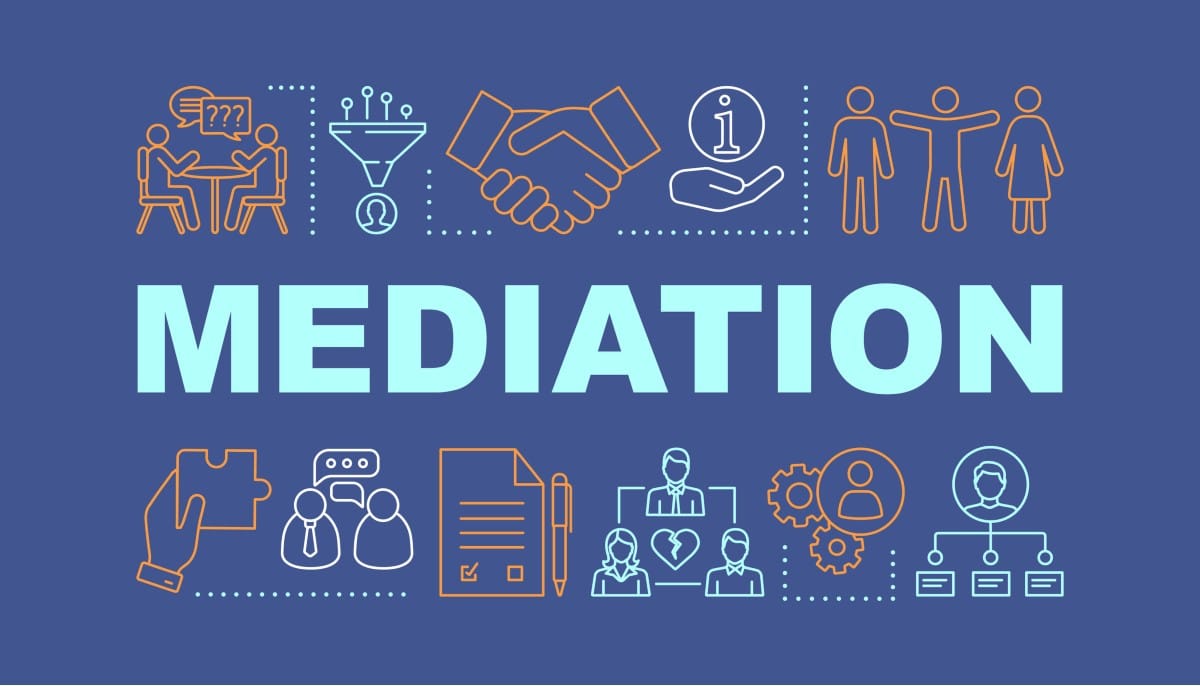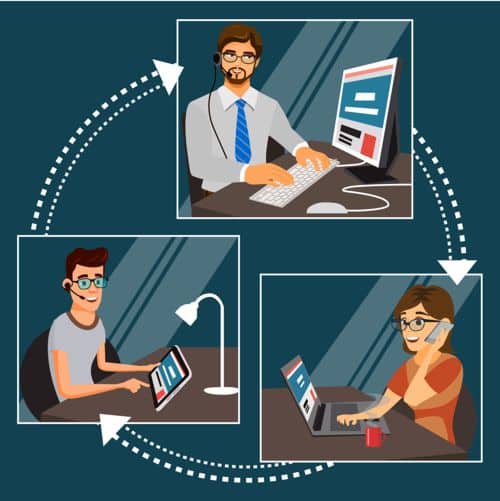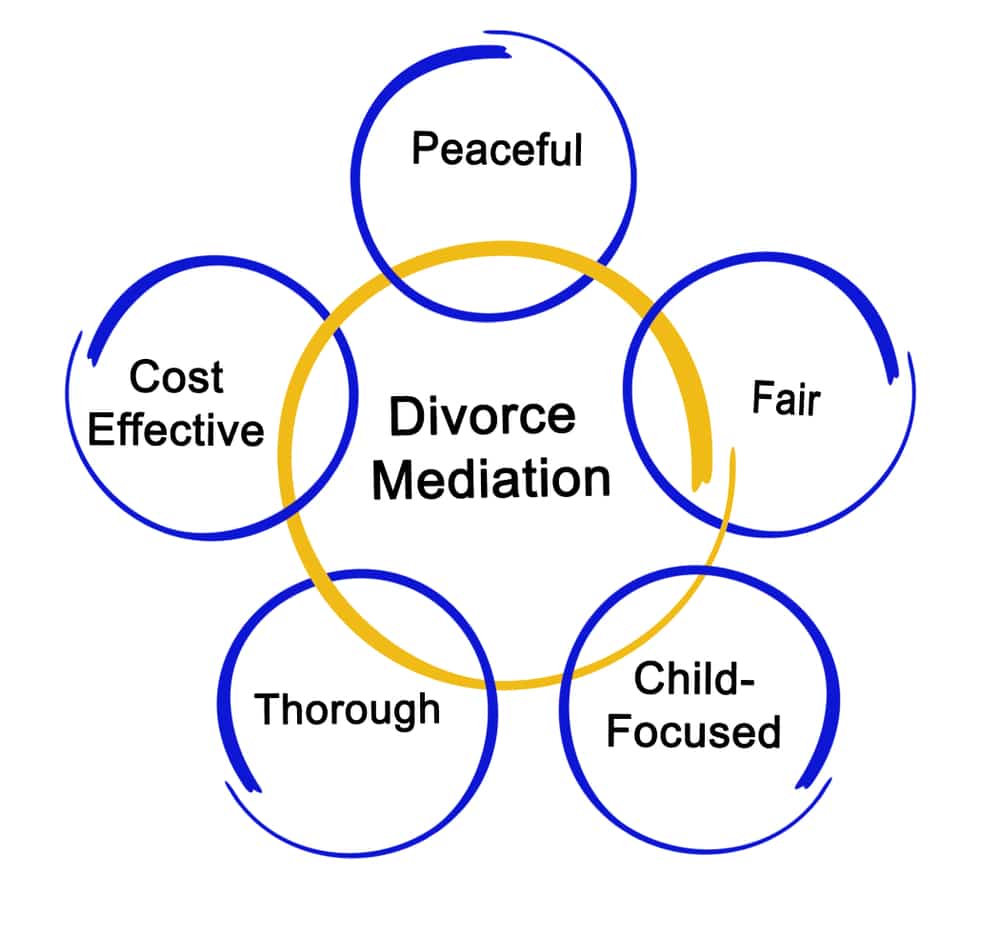How Online Divorce Mediation Simplifies Your Separation
Navigating divorce can be challenging, but “virtual divorce mediation” and “online divorce mediation” offer efficient, private, and amicable solutions. In Ontario, understanding these processes is crucial for couples seeking a less contentious separation. With online mediation, couples can resolve family matters without the stress of court appearances. This method utilizes technology to facilitate conflict resolution, ensuring both parties can work towards a fair agreement at their convenience. Dive into this blog post to explore how virtual divorce mediation can make your separation smoother and more manageable.
Divorce Mediation Online is one of the alternative dispute resolution processes. It is a facilitative process between two or more disputing parties overseen by a neutral third party. When the mediation is online the third party is known as an online mediator.

Why Choose Virtual Divorce Mediation

Virtual Mediation for a Divorce Soft Landing
Can mediation be done virtually? I’m ready to help
Who are my Typical Clients
Divorce mediation agreements reached in Ontario can be legally binding if they meet certain requirements. While the mediator’s role is to facilitate discussions and assist the parties in reaching a mutually satisfactory agreement, the final agreement itself may need to be formalized to have legal effect.
To make a divorce mediation agreement legally binding in Ontario, it is advisable to follow these steps:
- Independent Legal Advice: After agreeing in mediation, each party is recommended to seek independent legal advice from their lawyer. This ensures that each party understands their rights, obligations, and the implications of the agreement.
- Documentation: The mediated agreement should be documented in writing, typically as a separation agreement. The agreement should clearly outline the agreed-upon terms, such as child custody and access, support payments, property division, and any other relevant matters.
- Incorporation into Court Order: To make the mediation agreement legally binding and enforceable, it is common practice to incorporate the agreement into a court order. This involves filing the agreement with the court and obtaining an order that reflects the terms of the agreement. This step provides the agreement with the force of a court order and enables enforcement if necessary.
- Independent Legal Review: Before signing the court order, it is essential for each party to have their own lawyer review the document to ensure that their rights and interests are protected. This step helps verify that the agreement is fair, complies with the law, and is in both parties’ best interests.
By following these steps, the mediation agreement can be transformed into a legally binding document that provides the enforceability and protection. It is important to consult with legal professionals to understand the requirements and processes for making a mediation agreement legally binding in Ontario.
Divorce mediation offers several benefits that make it a favourable option for couples going through a divorce. Here are some reasons divorce mediation is good:
Maintains Control: In mediation, the parties have greater control over the outcome. They actively participate in the decision-making process rather than leaving the decisions solely in the hands of a judge. This empowers the individuals involved to shape the terms of their divorce based on their unique needs and circumstances.
Promotes Amicable Resolutions: Mediation encourages open communication, cooperation, and problem-solving. It fosters a more amicable and respectful environment compared to an adversarial court process. Mediation focuses on finding mutually agreeable solutions that prioritize the best interests of both parties, allowing for a smoother transition and potentially preserving relationships, particularly in cases involving children.
Cost-Effective: Mediation is often more cost-effective than traditional litigation. It typically involves fewer sessions and less time spent in court, resulting in lower legal fees. The parties share the cost of mediation, reducing the financial burden compared to the individual representation required in a litigated divorce.
Confidential and Private: Mediation proceedings are confidential, ensuring that sensitive information shared during sessions remains private. This confidentiality creates a safe space for open and honest discussions, encouraging parties to freely express their concerns and explore potential solutions without fear of public disclosure.
Flexible and Customized Solutions: Mediation allows for flexible and creative problem-solving. The parties can tailor their agreements to meet their specific needs rather than adhering to strict court-imposed solutions. This flexibility enables more customized outcomes, particularly regarding child custody, visitation schedules, and division of assets.
Reduces Emotional Stress: Mediation provides a supportive and non-adversarial environment that can reduce the emotional stress often associated with divorce. The mediator helps manage emotions, facilitates constructive communication, and focuses on finding mutually satisfactory resolutions, ultimately promoting a healthier transition for everyone involved.
Overall, divorce mediation offers an alternative approach that prioritizes collaboration, empowerment, and long-term satisfaction. By choosing mediation, individuals can make informed decisions, maintain control over their divorce process, and work towards agreements that reflect their unique needs and goals.
The hardest part of divorce mediation can vary depending on the specific circumstances and the dynamics between the parties involved. However, some common challenges that couples may encounter during mediation include:
- Emotional Turmoil: Divorce is an emotionally charged process, and navigating the emotional aspects can be challenging. Dealing with grief, anger, resentment, and other intense emotions can make it difficult to engage in productive discussions and make clear-headed decisions. Managing emotions and effectively communicating despite the emotional strain can be one of the most challenging aspects of divorce mediation.
- Power Imbalance: Power dynamics can exist in relationships and may persist during mediation. When one party feels overpowered or disadvantaged, it can hinder the negotiation process. Achieving a sense of fairness and ensuring that both parties have equal opportunities to express their concerns and perspectives is crucial but challenging to navigate.
- Complex Financial Matters: Divorce often involves intricate financial considerations such as asset division, spousal support, and child support. Understanding the financial implications and finding equitable solutions can be daunting, especially when substantial assets or complex financial structures are involved. The parties may need to consult additional experts, such as financial advisors or accountants, to grasp the financial aspects and make informed decisions fully.
- Communication and Miscommunication: Effective communication is essential for successful mediation, but miscommunication or breakdowns in communication can occur. Differences in communication styles, misunderstanding intentions, or difficulty expressing needs and concerns can hinder progress. Overcoming communication barriers, listening actively, and communicating clearly can be significant challenges.
- Resistance to Change: Divorce represents a significant life transition, and it often involves adjusting to new roles, routines, and living arrangements. Some parties may resist change or struggle to envision a future beyond marriage. Overcoming resistance and embracing the opportunities for growth and a fresh start can be emotionally challenging.
It’s important to recognize that these challenges are not insurmountable, and a skilled mediator can help guide the parties through them. By fostering open communication, addressing emotional concerns, and providing support and guidance, mediators help parties overcome obstacles and work towards reaching mutually satisfactory agreements.
The three main types of divorce mediation commonly practiced are facilitative, evaluative, and transformative. Here’s a brief explanation of each:
Facilitative Mediation: This type of mediation focuses on facilitating open communication and guiding the parties through reaching a mutually acceptable agreement. The mediator acts as a neutral facilitator, helping the parties identify their issues, explore possible solutions, and make informed decisions. The mediator does not provide legal advice or decisions on behalf of the parties but helps foster a cooperative environment where the parties can collaborate to find resolutions.
Evaluative Mediation: In evaluative mediation, the mediator takes a more proactive role in providing legal guidance and expertise. They may assess the strengths and weaknesses of each party’s legal position and offer their evaluation or opinion on potential outcomes if the case were to go to court. Evaluative mediators may also suggest potential settlement options based on their legal knowledge and experience. I often used this approach in more complex cases or when the parties seek a mediator’s expert assessment of the likely legal outcomes.
Transformative Mediation: Transformative mediation empowers parties and promotes personal growth and understanding. The mediator encourages open communication, active listening, and recognition of each party’s perspective. The goal is not solely to settle but to transform the relationship and dynamics between the parties. Transformative mediators help the parties develop their problem-solving skills and support them in finding their own solutions. This type of mediation focuses on addressing the underlying issues and facilitating personal and relational growth.
It’s important to note that these types of mediation are not mutually exclusive, and mediators often integrate elements from different approaches based on the needs and dynamics of the specific case. The chosen mediation style will depend on the parties’ preferences, the nature of the dispute, and the desired outcomes.
Divorce mediation in Ontario is a process in which a neutral third party, known as a mediator, assists couples in resolving their divorce-related issues outside of the courtroom. The mediator facilitates constructive communication and guides the parties toward reaching mutually acceptable agreements.
Here’s a general overview of how divorce mediation works in Ontario:
Initial Consultation: The process begins with an initial consultation, where the mediator explains the mediation process, its benefits, and addresses any concerns or questions the couple may have. This consultation allows the couple to assess whether mediation is the right approach for them.
Sessions and Discussions: If both parties agree to proceed with mediation, they will attend mediation sessions with the mediator. During these sessions, the mediator helps the couple identify their issues, concerns, and goals. They guide discussions to foster understanding, encourage effective communication, and facilitate productive negotiations.
Information Gathering: The mediator may request relevant financial documents, such as bank statements, tax returns, or property valuations, to facilitate informed decision-making during the mediation process. Full disclosure of financial information is essential for fair and equitable agreements.
Issue Identification and Exploration: The mediator assists the couple in identifying and prioritizing the key issues that need to be resolved, such as child custody, spousal support, division of assets, and more. They explore different options and help the couple consider creative solutions that meet their unique needs and circumstances.
Negotiation and Agreement: With the mediator’s guidance, the couple engages in negotiations to find common ground and reach agreements on each issue. The mediator ensures that both parties have an equal opportunity to express their views and concerns. The goal is to create durable and mutually satisfactory agreements that promote a cooperative post-divorce relationship.
Finalizing the Agreement: Once the couple has reached agreements on all relevant issues, the mediator can draft a memorandum of understanding or a separation agreement reflecting the terms of their settlement. It is advisable for each party to have an independent lawyer review the agreement before signing it to ensure their rights and interests are protected.
It’s important to note that divorce mediation is a voluntary process, and any agreements reached are not legally binding until they are incorporated into a court order or separation agreement.
By choosing mediation, couples in Ontario can actively participate in the decision-making process, maintain control over their outcomes, and work towards a more amicable and cost-effective resolution to their divorce.
The success rate of mediation in Ontario is high, in the area of 80%. While specific statistics may vary, mediation has proven to be an effective method for resolving disputes and reaching mutually satisfactory agreements.
One of the key advantages of mediation is that it empowers the parties involved to participate in the decision-making process actively. With the guidance of a skilled mediator, individuals can openly communicate, express their interests, and work together to find common ground. This collaborative approach often leads to more durable and customized solutions that meet the parties’ unique needs.
Successful mediation outcomes depend on various factors, including the willingness of the parties to engage, their commitment to finding common solutions, and the expertise of the mediator facilitating the sessions. When these elements align, mediation is likely to achieve positive results.
It’s important to note that success in mediation is not solely defined by reaching a complete agreement on every issue. Even partial agreements or narrowing down areas of disagreement can be successful outcomes, as they help pave the way for further negotiations or other dispute resolution methods if necessary.
Mediation provides a valuable alternative to traditional litigation, offering a higher potential for resolving conflicts amicably and preserving relationships. The success rate of mediation in Ontario underscores its effectiveness in helping individuals find mutually beneficial solutions outside of the courtroom.
It’s the mediator’s job to ensure both parties get an equal chance to state their case during mediation sessions, so no one side of the story will be dominant. If it turns out that one side is overpowering the other, the mediation session will be halted. However, it is often the case that spouses who deem themselves the ‘weaker’ of the partners, prove to be able to successfully state their case and get the result they want from mediation.
After starting with a lawyer, many of our clients find us. It is never too late to mediate.
If you have a question or two after reviewing our website, we recommend that you schedule a complimentary 15-minute call. We will address your questions and determine your next steps. You can do so by CLICKING HERE.
Most often it is not as much ‘not wanting’ to reach agreement but ‘knowing how’ to decide. A mediator can convey a fresh perspective. The mediator’s own experiences and knowledge can support the parties to explore alternatives that may not have previously considered.
Lawyers and Family Court can always come later if no progress is made in mediation. With Divorce mediation you pay-as-you-go, there is limited financial jeopardy in trying to use mediation even if you are skeptical. You could devote a few hundred dollars to find out a settlement is not in reach and end up in Family Court anyway. However, there is a greater likelihood that you will settle in mediation if you start. In that event, you may have saved yourself tens of thousands of dollars
I offer virtual divorce mediation services which can be conducted online so you don’t have to share the same space with your spouse.
What happens after divorce mediation?
That’s not a problem as we provide online mediation services that couples use, even if they are within easy reach of our offices.
We can mediate across a whole range of divorce issues, but as we are financial experts, that’s the area in which we can add the most value.
No, my job as Divorce Mediator is to get you talking with your spouse so you can sort things out between you, not to offer my opinions. If you hire me as a Certified Divorce Financial Specialist instead of a Mediator, I will be able to recommend the best division of assets as well as the best childcare and spousal support solutions. If you hire me in this role, I will not work as your Mediator.
Start by gathering all your financial information. I can give you a list of things I’ll need if you email ken@dtsw.ca Also, take time to think about what’s the most important result for you to get from your divorce settlement and what your partner might want. Draw up a list of areas you want to discuss during mediation, and be sure to enter into sessions with a determination to compromise over those things that don’t really matter that much. If your mediation is charged on an hourly basis, you don’t want to be wasting time arguing over trivialities. You may want to checkout my ebook How to Prepare for Separation and Divorce HERE
In Ontario, both parties involved typically share the costs of divorce mediation. It is common for the parties to split the mediation fees equally or in a manner agreed upon between them. However, the specific financial arrangement can be negotiated and determined during mediation.
It’s important to note that besides the mediator’s fees, there may be other costs associated with mediation, such as administrative fees, document preparation, or the involvement of additional professionals like lawyers or financial experts. These costs are typically the responsibility of the individuals seeking mediation.
Some individuals may have access to legal aid or other financial help programs that can help cover the costs of mediation. It is advisable to explore these options and consult with a legal professional to understand the resources and support in managing the financial aspects of divorce mediation.
Ultimately, the financial arrangements for divorce mediation in Ontario can vary based on the specific circumstances of each case, the agreement reached between the parties, and any available financial assistance programs. Open communication and discussing financial matters early on in the mediation process can help establish a fair and manageable arrangement for both parties involved.
The cost of divorce mediation in Ontario can vary depending on several factors, such as the complexity of the issues, the experience and qualifications of the mediator, the number of sessions required, and any additional services or professionals involved.
Divorce mediation in Ontario can range from approximately $150 to $500 per hour for the mediator’s fees. The hourly rate will depend on the mediator’s expertise, reputation, and location. Some mediators offer package deals or discounted rates for multiple sessions.
It’s important to note that besides the mediator’s fees, there may be additional costs associated with divorce mediation. These can include administrative fees, document preparation, the involvement of financial experts or other professionals, and potentially legal fees if parties choose to consult with their lawyers throughout the mediation process.
Overall, divorce mediation is often more cost-effective than a traditional litigated divorce. The ability to work together in a cooperative environment, avoid lengthy court proceedings, and reach mutually agreeable solutions can save significant time and money.
It’s advisable to consult with mediators directly to discuss their fee structures, payment arrangements, and any potential additional costs. Some mediators offer a free initial consultation or a “Get Acquainted Call” to discuss fees and answer questions about the mediation process.
External links that may interest you
- 6 Tips to Prepare for Your Online Mediation: Familiarize yourself with platforms, ensure stable internet, and charge devices.
- How to Prepare for Online Mediation: A Guide for Lawyers: Schedule a rehearsal session and set up calls with client representatives.
- Mediator Guide to Online Mediation: Hold introductory or preparation calls using videoconference for better presentation.
- 40 Essential Tips For Your Online Mediation: Avoid interruptions, stay engaged, and keep children in a separate space.
- Preparing for Online Mediation with Zoom – Advocate Magazine: Have documents and notes available at arm’s reach for easier access.
- Using E-Mediation and Online Mediation Techniques: Technology makes professional dispute resolution more accessible when face-to-face meetings are difficult.
- Tips for Successful Virtual Mediations: Proper preparation is key to the success of online mediation.
- Effective Online Mediation: Practice Tips: Prepare parties for mediation, manage initial sessions, and effectively caucus.
- How to Make the Most of Your Online Mediation Sessions: Learn how to utilize online mediation for effective dispute resolution.
- 10 KEYS for Achieving a Successful Online Mediation: Tips include equipment tests and honest communication.
- How to Prepare for a Virtual Mediation: Ensure scheduling ease and preparation for all attendees.
- Tips For A Successful Online Mediation: Choose the right mediator and prepare for technical difficulties.
- How to Master Online Mediation and Negotiation: Select suitable platforms, prepare technology, and manage emotions.
- Methods of Dispute Resolution: Building Trust in Online Mediation: Build trust from the start with guided tours of the mediation platform.
- How to Prepare for an Online Mediation: Learn what to expect when scheduling your first online mediation.
- How Does Online Mediation Work? A Guide to Zoom: Review documents related to the dispute and set clear goals.
- Online and Video Mediation – FAQ and Answers: Conduct test runs of video technology before the mediation.
- Using Zoom to Conduct Online Mediation: Prepare all necessary materials and ensure private chat settings.
- Online Video Mediation: Learn about the communication skills used by mediators in online settings.
Ken Maynard CDFA, Acc.FM
I assist intelligent and successful couples in crafting rapid, custom separation agreements that pave the way for a smooth transition towards a secure future. This efficient process is achieved in about four meetings, effectively sidestepping the excessive conflicts, confusion, and costs commonly linked to legal proceedings. Clients have the flexibility to collaborate with me either via video conference or in-person through a DTSW associate at any of our six Greater Toronto mediation centers, located in Aurora, Barrie, North York, Vaughan, Mississauga, and Scarborough.
Have a few questions - Tap here to Schedule a Get Acquainted Call























































